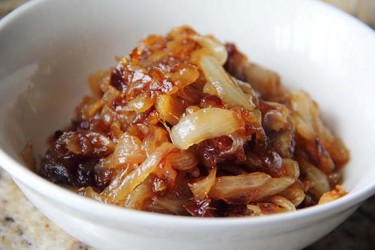Hi Everyone,
A couple of weeks ago I was telling you about sweating onions, well this week, it is about caramelizing the alliums.
Pickled, baked, fried, grilled, roasted, sautéed, stuffed, sweated, or raw, onions are delicious. While in most cases they are a part of an entire dish, when caramelized, onions are the star and the main ingredient. It is the main application in which the natural flavour of the onion is extracted and concentrated. Tender and sweet yet retaining savoury notes, caramelized onions are a treat!
To caramelize onions is to cook them low and slow until they turn brown, tender and candy-sweet. It is not a fast food and by that I mean that it is not something that is cooked quickly, on average it takes at least 1 hour to make caramelized onions. The cooking time would vary depending on the heat, pan and quantity of onions, but the bottom line is this – you can’t hurry caramelized onions.

Caramelized onions are great in soups, sandwiches, with pasta, rice, ground provisions, pizzas, breads, biscuits meat, fish or egg dishes. Stir-fries, casseroles, stews and salads also benefit from the sweet-savoury yummy flavour of caramelized onions. To use the onions, you can simply top them on to your food such as biscuits and toast points to make an appetizer, stir them in to your cooked food, like a salad, serve them alongside food, for example steaks, chops and roasts or cook them in to dishes such as soups or stews. Top your burgers with them or layer the onions on some sharp salty cheese to make a sandwich that would have you groaning with pleasure.

Before I get into telling you how to make the caramelized onions, I want you to understand something: caramelized onions are onions that have cooked down to the stage where they are soft, reduced by more than half of their original volume, and have become brown and sweet. When they have caramelized you can opt to season them with a little salt and freshly ground black pepper. Or, you can leave them just as they are.
To make caramelized onions you need 3 things – onions, a fat (oil, butter or a combination) and time.
The onions
The best onions to use are the ones we get all the time here in the region – the Spanish onion – the onions with the brown-paper skin. They are the sweetest for this application. White onions and red onions can also be used, however, both onions are milder in flavour and contain less sugar. If using white or red onions, you might like to add a little sugar closer to the time that the onions are finished cooking to boost the sweetness.
Cut the onions into ¼-inch thick slices or a little thicker if you like; this way, the onions when cooked down will still look like onions. You can certainly slice them thinly; they will cook faster but will end up mushy (though still delicious).
The pan
Stainless steel or cast iron work well. While you can use a non-stick pan, it will not get you the kind of caramelization needed and that is simply because no fond (the stuck on brown bits) will develop and that is an integral part to the flavour of the cooked onions.
The fat
Oil, butter or a combination of both can be used. I prefer to use a neutral flavoured oil such as vegetable, peanut or canola. The use of butter is about adding flavour. While the flavour is fine, I find that the butter browns too quickly before the onions are done cooking.
The heat
As I have said before, caramelized onions are a slow food, therefore, the heat has to be regulated. Start off with medium heat and then lower the heat so that the onions can cook at a steady rate to get to the stage of caramelization. It is not a case where you have to stand at the stove all the time. Checking the onions every 5 to 10 minutes works perfectly. Give them a turn on each occasion and rub the bottom of the pan with your spoon or spatula to release the fond and mix it in to the onions.
The fond
As the onions cook, they will release their juices that have in some of their sugars. The juices get transferred to the bottom of the pan and brown bits develop. It could seem as if things are burning but they are not. You need to use a wooden spoon or hard plastic spatula or spoon to help scrape off the fond that you mix with the onions as they cook. Removing the fond and stirring it in to the onions as they are cooking is something that you have to do each time you check on the onions (every 5 – 10 minutes).
Deglazing & seasoning
Deglazing is a cooking technique whereby some type of liquid is added to a hot pan to remove bits stuck on to the bottom and sides of a pan. A lot of flavour lies in those brown bits at the bottom of the pan and should not be wasted. If you have not been able to remove all or most of the fond at the bottom of the pan in which you caramelized the onions, deglaze the pan with some wine, stock, balsamic vinegar or water. You don’t need a lot, just enough to assist in removing the fond. Whatever type of liquid you add will add flavour to the onions. Let the onions continue to cook until they have absorbed the liquid.
While you can add salt early on when cooking the onions (this will draw out moisture), I think it is best to add it towards the end, here’s why: The onions will significantly reduce in volume when caramelized and you run the risk of adding too much salt if the onions are seasoned at the onset when they are raw and at full volume. The other thing is this, wait until the onions are caramelized and taste them to determine whether you need to season at all or if just a little.
I would suggest that if you want to add some salt to the onions early, only use a light sprinkling.
Storage
Caramelized onions can be used immediately after they are made. However, if you are not going to use them right away, let them cool in the pan then transfer them to an airtight container and refrigerate. They can stay refrigerated for a week and up to 3 months in the freezer.
Look out next week Sunday, In Good Taste, for a recipe of flatbread with caramelized onions.
Have a great weekend!
Cynthia
Cynthia@tasteslikehome.org
www.tasteslikehome.org





